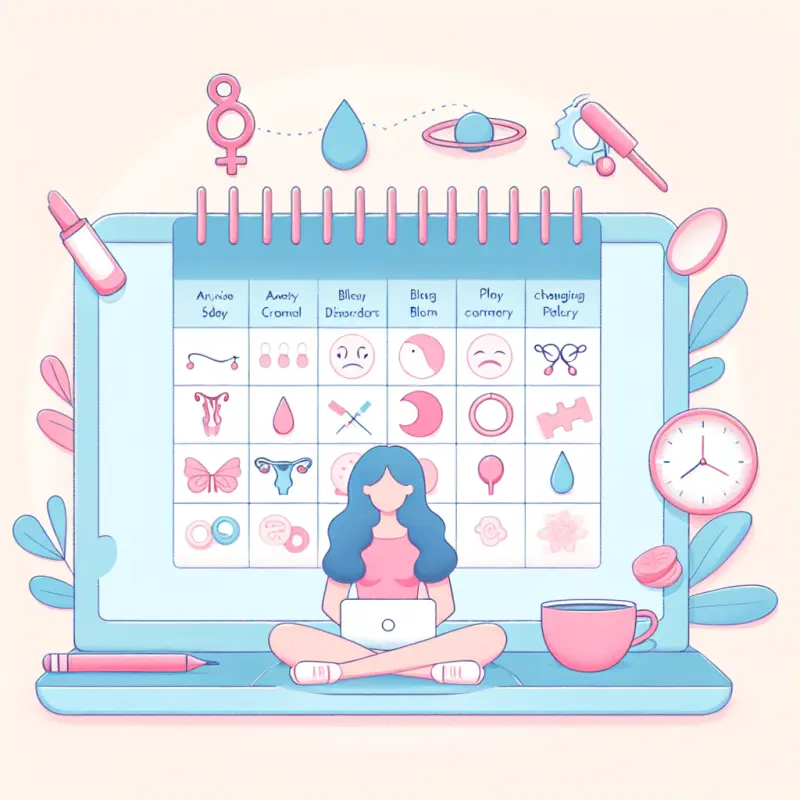Anxiety Disorders and Menstrual Cycle Fluctuations

Anxiety Disorders and Menstrual Cycle Fluctuations
Introduction
The menstrual cycle is a natural, physiological process that affects millions of women worldwide. While it is often discussed in terms of its reproductive function, its impact on mental health is an equally important topic that deserves attention. Anxiety disorders, one of the most common mental health conditions, can significantly affect a woman's quality of life. Interestingly, research has shown that the menstrual cycle can influence anxiety levels, potentially exacerbating symptoms at certain times of the month. This article delves into the complex relationship between anxiety disorders and menstrual cycle fluctuations, exploring the biological, psychological, and social factors involved.
Understanding Anxiety Disorders
What Are Anxiety Disorders?
Anxiety disorders encompass a range of mental health conditions characterized by excessive fear, worry, and nervousness. These disorders significantly impact daily functioning and include:
- Generalized Anxiety Disorder (GAD)
- Panic Disorder
- Social Anxiety Disorder
- Specific Phobias
- Obsessive-Compulsive Disorder (OCD)
- Post-Traumatic Stress Disorder (PTSD)
Symptoms of Anxiety Disorders
Common symptoms include:
- Persistent worry or fear
- Restlessness or feeling on edge
- Fatigue
- Difficulty concentrating
- Irritability
- Sleep disturbances
- Physical symptoms such as increased heart rate, sweating, and trembling
Prevalence and Impact
Anxiety disorders are the most prevalent mental health conditions, affecting approximately 18% of adults in the United States. Women are nearly twice as likely as men to experience these disorders, raising questions about the role of hormonal and reproductive factors.
The Menstrual Cycle: An Overview
Phases of the Menstrual Cycle
The menstrual cycle typically lasts 28 days and consists of four main phases:
- Menstrual Phase (Days 1-5): Shedding of the uterine lining, resulting in menstruation.
- Follicular Phase (Days 1-13): The pituitary gland releases follicle-stimulating hormone (FSH), stimulating the ovaries to produce follicles. Estrogen levels rise, thickening the uterine lining.
- Ovulation (Day 14): A surge in luteinizing hormone (LH) causes the release of an egg from the dominant follicle.
- Luteal Phase (Days 15-28): The corpus luteum forms, producing progesterone to prepare the uterine lining for potential pregnancy. If pregnancy does not occur, hormone levels drop, leading to menstruation.
Hormonal Fluctuations
Throughout the menstrual cycle, levels of estrogen and progesterone fluctuate, influencing not only reproductive functions but also mood and emotional well-being.
The Link Between Anxiety Disorders and Menstrual Cycle
Hormonal Influence on Anxiety
- Estrogen: Known to have a protective effect against anxiety, estrogen stimulates the production of serotonin, a neurotransmitter that regulates mood. Low levels during the menstrual cycle may contribute to heightened anxiety.
- Progesterone: While it has a calming effect for some women, high levels of progesterone can increase sensitivity to stress and anxiety in others.
Phases Most Affected
- Luteal Phase: The premenstrual period often sees a spike in anxiety symptoms due to falling estrogen and fluctuating progesterone levels. This phase is associated with premenstrual syndrome (PMS) and premenstrual dysphoric disorder (PMDD), both of which include anxiety as a symptom.
- Menstrual Phase: The onset of menstruation can also exacerbate anxiety symptoms, potentially due to physical discomfort and hormonal changes.
Biological Mechanisms
Neurotransmitter Systems
- Serotonin: Fluctuating hormone levels can impact serotonin production, influencing mood and anxiety levels.
- Gamma-Aminobutyric Acid (GABA): Progesterone metabolites can modulate GABA receptors, affecting anxiety responses.
Stress Response
The hypothalamic-pituitary-adrenal (HPA) axis, which regulates the stress response, may be influenced by hormonal changes, affecting anxiety levels throughout the menstrual cycle.
Psychological and Social Factors
Body Image and Self-Perception
Hormonal fluctuations can affect body image and self-perception, leading to increased anxiety about appearance and social interactions.
Social and Cultural Influences
Societal expectations and cultural norms regarding menstruation can contribute to anxiety, especially in environments where menstruation is stigmatized or misunderstood.
Coping Strategies and Treatments
Lifestyle Modifications
- Diet: Consuming a balanced diet rich in omega-3 fatty acids, magnesium, and vitamin B6 can support mood regulation.
- Exercise: Regular physical activity has been shown to reduce anxiety symptoms by releasing endorphins and improving sleep quality.
- Sleep Hygiene: Maintaining a consistent sleep schedule and creating a restful environment can mitigate anxiety symptoms.
Psychological Therapies
- Cognitive Behavioral Therapy (CBT): CBT helps individuals identify and challenge negative thought patterns, providing effective tools for managing anxiety.
- Mindfulness and Relaxation Techniques: Practices such as yoga, meditation, and deep-breathing exercises can reduce stress and promote emotional balance.
Medical Treatments
- Hormonal Therapy: Birth control pills or other hormonal treatments may stabilize hormone levels, potentially reducing anxiety symptoms.
- Medication: Antidepressants and anti-anxiety medications can be effective for managing severe anxiety disorders, but should be used under medical supervision.
Conclusion
The interplay between anxiety disorders and menstrual cycle fluctuations is complex, involving biological, psychological, and social factors. Understanding the hormonal influences on anxiety can help women recognize patterns in their symptoms and seek appropriate treatment. While lifestyle modifications and psychological therapies can provide significant relief, medical interventions may be necessary for severe cases. By fostering awareness and reducing stigma, we can better support women in managing anxiety disorders in relation to their menstrual cycles. This holistic approach not only improves mental health outcomes but also enhances overall well-being.
This article aims to provide a comprehensive understanding of how anxiety disorders interact with menstrual cycle fluctuations. By exploring the various facets of this relationship, we hope to empower women with the knowledge and resources needed to navigate their mental health journey effectively.